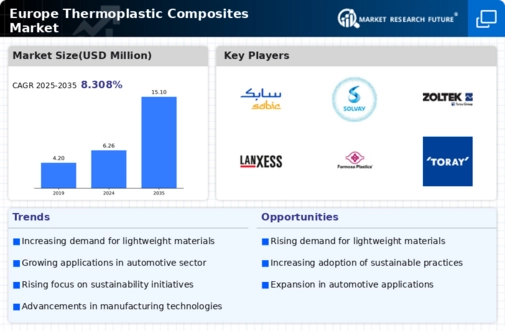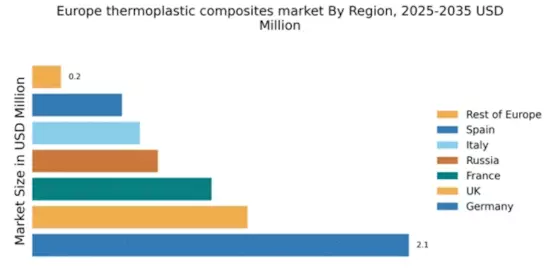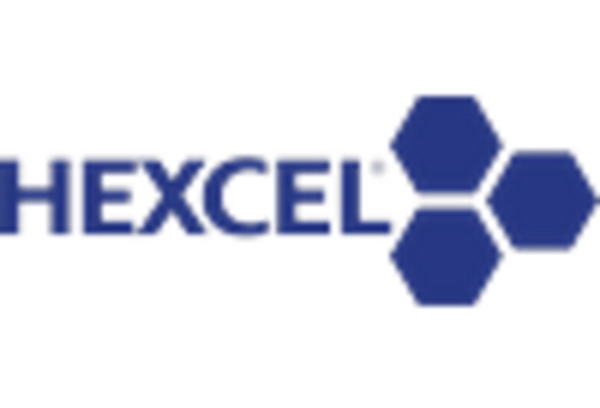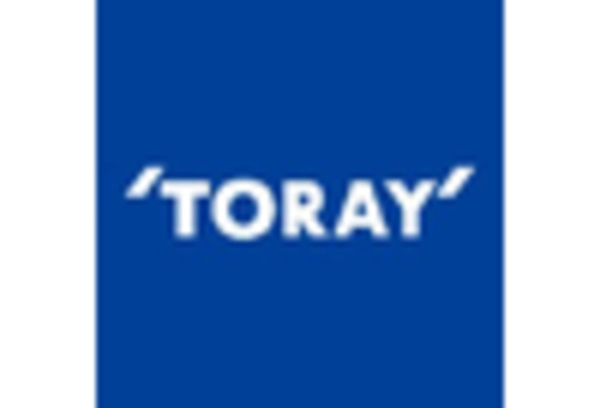Rising Demand for Lightweight Materials
The thermoplastic composites market in Europe experiences a notable surge in demand for lightweight materials, particularly in the automotive and aerospace sectors. As manufacturers strive to enhance fuel efficiency and reduce emissions, the adoption of thermoplastic composites becomes increasingly attractive. These materials offer a weight reduction of up to 30% compared to traditional materials, which is crucial for meeting stringent regulatory standards. In 2025, the market is projected to grow at a CAGR of 8%, driven by the need for innovative solutions that combine strength and lightness. This trend indicates a shift towards advanced materials that not only improve performance but also align with environmental goals, thereby propelling the thermoplastic composites market forward.
Regulatory Support for Advanced Materials
The thermoplastic composites market in Europe benefits from regulatory support aimed at promoting the use of advanced materials. European Union policies encourage the adoption of lightweight and sustainable materials across various industries, including automotive, aerospace, and construction. This regulatory framework not only facilitates market entry for new products but also incentivizes manufacturers to invest in thermoplastic composites. By 2025, it is anticipated that compliance with these regulations could lead to a market expansion of approximately 15%, as companies align their strategies with sustainability goals. This supportive environment is crucial for driving innovation and ensuring that the thermoplastic composites market remains competitive in a rapidly evolving landscape.
Collaboration Between Industry and Academia
Collaboration between industry and academia is emerging as a pivotal driver for the thermoplastic composites market in Europe. Partnerships between universities and manufacturers facilitate knowledge transfer and foster innovation in material development. These collaborations often result in the creation of cutting-edge technologies and processes that enhance the properties of thermoplastic composites. By 2025, it is expected that such partnerships could lead to the introduction of several new products, potentially increasing market share by 12%. This synergy not only accelerates the pace of innovation but also ensures that the thermoplastic composites market remains at the forefront of technological advancements, addressing the needs of various industries effectively.
Growing Applications in the Construction Sector
The construction sector in Europe is increasingly recognizing the advantages of thermoplastic composites, leading to a diversification of applications. These materials are being utilized in various structural components, facades, and interior elements due to their durability, resistance to corrosion, and aesthetic appeal. The market for thermoplastic composites in construction is projected to grow by 10% annually, as builders seek to enhance the longevity and performance of their projects. This trend indicates a broader acceptance of advanced materials in traditional industries, thereby expanding the potential customer base for thermoplastic composites. The integration of these materials into construction practices signifies a shift towards more innovative and efficient building solutions.
Increased Investment in Research and Development
Investment in research and development (R&D) within the thermoplastic composites market in Europe is on the rise, as companies seek to innovate and improve product offerings. This focus on R&D is essential for developing new formulations and processing techniques that enhance the performance characteristics of thermoplastic composites. In 2025, it is estimated that R&D expenditures in this sector could reach €500 million, reflecting a commitment to advancing material science. The emphasis on developing high-performance composites that can withstand extreme conditions is likely to attract further investment, thereby fostering growth in the thermoplastic composites market. This driver highlights the importance of innovation in maintaining competitive advantage and meeting evolving customer demands.


















Leave a Comment